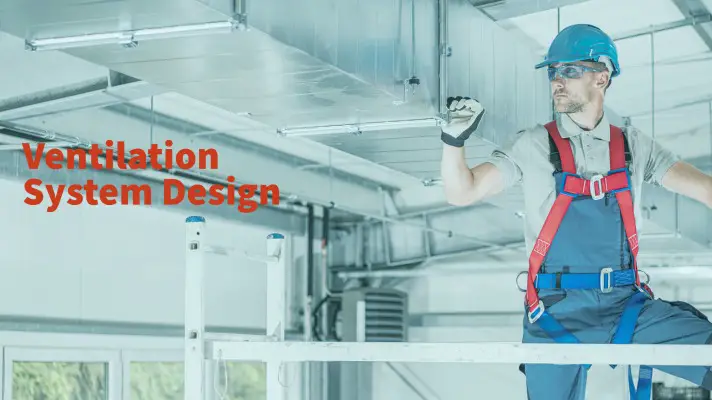The ventilation system is required for the proper circulation of air in an enclosed area. Lack of a proper ventilation system may accumulate carbon-di-oxide, smoke, and other harmful gases depending on the application of the area. Before moving to Mechanical Ventilation MCQ, let us start with the Basic of the ventilation system.
Here, I will explain how to design a ventilation system, how to calculate the fan capacity, etc. Also, at the end of this article, you will come to know how much air changes are required in different rooms.

Classification of the ventilation system
Depending on the fan used:
Natural ventilation
Natural ventilation is a process by which polluted air from the room is thrown outside with the help of natural forces. No mechanical means are used here.
Air circulation is maintained through windows and louvers. Room hot, polluted air becomes heavier than outside fresh air. Due to temperature differences, there exists a density difference. Accordingly, the fresh air louvers/ windows are placed on the room wall.
Supply air louvers are given at a low level whereas exhaust air louvers are given at a high level.
Mechanical ventilation system
When a room or an area can’t circulate the air naturally, mechanical forces are used in circulating the air. In this system, fans are used to supply fresh air and to exhaust the hot, polluted air outside.
Mechanical ventilation systems or Dry type ventilation systems can be classified into three types:
Ventilation through only Supply
In this system, tube-axial fans or centrifugal fans depending on the application and room size are used for supplying the air. The exhaust is made through windows or louvers.
Ventilation through only Exhaust
In this system, tube-axial or centrifugal fans are used to throw out the room inside and hot air into the outside. Fresh air is supplied through windows or louvers.
Ventilation through both Supply and Exhaust
In this system, fresh air is supplied through the supply air fans and hot, polluted air is thrown out with the help of exhaust air fans.
Also, depending on the pressure maintained inside the room, the ventilation system is classified into two types. They are positive pressurized ventilation and negatively pressurized ventilation.
In the case of the positive pressurized ventilation system, the supply air quantity is kept more than that of exhaust air to maintain the positive pressure inside the room. In this case, room pressure should be 2.5 Pa more than the outside area. The purpose of this ventilation to not to allow dust ingress from outside. For this, the supply air should be 10-15% more than that of the exhaust air.
In switchgear rooms, MCC rooms, cable vaults, AC plant rooms, etc. positive pressurized ventilation system is used.
In the case of a negative pressurized system, the exhaust air quantity is kept more than that of the supply air to maintain the negative pressure inside the room. In this case, the room inside pressure should be 2.5 times less than the outside area. The purpose of this ventilation system is to remove the fumes, and harmful gases produced from the machines to outside the environment. As these gases are not good for the environment, they should be thrown at a certain height after filtering.
Also, this is used in hospitals where patients with airborne infections are treated. This infection may spread to people who are in hospitals for work or maybe for some other reason. To avoid this, negatively pressurized ventilation is used.
In Battery rooms, and chemical rooms negative pressurized ventilation system is used.
The temperature inside the room for the Dry Ventilation System
In the case of the dry ventilation system, room temperature can be restricted up to +5 degrees C from ambient temperature. If the ambient temperature is 43 degrees Celsius, after ventilating the room using a dry ventilation system, it will be a maximum of 48 degrees Celsius. Sometimes, due to the operations of the various machines, room temperature may go beyond 48 degrees Celsius if no ventilation system is envisaged inside the room.
Wet type Ventilation System or Evaporative cooling system
In the Wet type of ventilation system, room air is cooled with the help of water. Hence, another name for this ventilation system is the evaporative cooling system. Cool water takes the heat from the room’s hot air and becomes hot. As a result, the air becomes cool and is supplied to the room.
In Wet Type Ventilation System, the amount of temperature that can be dropped down depends on wet bulb temperature and saturation efficiency.
Name the rooms in a Power Plant that are ventilated. Name the areas where an Evaporative cooling system is applied.
Ans: The rooms that are mechanically ventilated are:
Battery Room
UPS Room
AC Plant Room
SWAS wet panel room
MCC Room at the clarified water pump house
All pump houses
Compressor house
Pantry
Toilets
Out of these rooms, Battery rooms, Pantry, and Toilets are maintained at negative pressure and the rest of the rooms are maintained at positive pressure.
For calculating the quantity of supply air, you should consider ACPH for all the above-mentioned rooms except MCC Room, Toilets, and Pantry. ACPH of the MCC room should be considered as 25-35 depending on the outside DBT. ACPH for toilets and Pantry should be considered as 10-20. The same will be specified in the Technical Specification of a project.
The areas that are ventilated through an evaporative cooling system are:
TG Hall
Switchgear Room at TG Building
MCC Room at TG Building
Cable Vault at TG Building
ESP/VFD room
For these areas, the air is supplied through the Air Washer duct, and exhaust is made either through the exhaust air fan or through roof extractors. These areas are maintained at positive pressure.
Ventilation System Design
First, calculate the volume of the room to be ventilated. Next, find out the ACPH mentioned in the Client’s specification or you may find the same in the NBC handbook or ISHRAE handbook.
Ventilated air quantity = Volume x ACPH.
In this way, you have to calculate the ventilated air quantity required for all the rooms separately. Then, add all those quantities. Finally, it will give you the fan capacity required for ventilating those areas.
Short Questions on Ventilation System
What are louvers used in the ventilation system?
Ans: Louvers are openings that are equipped with blades that are inclined at certain angles. As a result, it does not allow dust and direct sunlight in entering the room., but allows the air in entering.
What are the differences between Louvers and Backdraft dampers?
Ans: Through Louvers air may be directed in the opposite direction. It means that one louver may supply or may exhaust air whereas Back Draft Dampers provide airflow in a particular direction.
Different cases may arise while designing the Ventilation system. For calculating the airflow required, you need to know the temperature difference if you calculate based on the heat generation. Here we will discuss some cases:
Suppose, there is a milling shade and within that one-panel room is there. This paneled room needs to be ventilated. How much temperature difference you will consider while calculating the air quantity?
Ans: The temperature of the Milling shade is = (Outside air dry bulb temperature +5 Degrees C)
Panel room temperature=Room inside DBT.
Temperature Difference = Temp of Milling Shed- Panel Room Temp
Suppose, there is a milling shade and within that one Control room is there. This Control room needs to be ventilated. How much temperature difference you will consider while calculating the air conditioning Tonnage?
Ans: In this case, you should consider the walls as partition walls as the shed is there surrounding the control room.
The heat gains through the partition wall = area of the wall * temp difference * transmission factor.
Transmission factor can be taken from ISHRAE Handbook.
Temp Difference = (OA. DBT+5 Deg C – IA DBT)
In a big Restaurant, for calculating the amount of air needed for the ventilation system of a kitchen, how much ACPH should be considered?
Ans: 60 ACPH
For factory-fabricated ducts, which standards should be used?
Ans: SMACNA
How to design the Toilet Ventilation system?
Ans: The toilet ventilation system should be designed based on 50 CFM per Urinal/WC or 15 ACPH, whichever is more.
Mechanical Ventilation MCQ
- By which device, we can remove the air from the suction and casing?
- Pump
- Blower
- Primer
- None of these
Ans: (3)
- In the Battery room ventilation system, the relation between supply air and exhaust air should be:
- Supply air quantity > exhaust air quantity
- Exhaust air Quantity > supply air quantity
- Supply air Quantity = exhaust air quantity
- None of these
Ans: (2)
- In the MCC Switchgear room ventilation system, the relation between supply air and exhaust air should be:
- Supply air quantity > exhaust air quantity
- Exhaust air Quantity > supply air quantity
- Supply air Quantity = exhaust air quantity
- None of these
Ans: (1)
- How dry ventilation is done?
- Using a unitary air filtration unit
- Using Air Washer System
- Using the Supply air fan and Exhaust air fan
- Using louvers and windows
Ans: (3)
- How natural ventilation is done?
- Using a unitary air filtration unit
- Using Air Washer System
- Using the Supply air fan and Exhaust air fan
- Using louvers and windows
Ans: (4)
- Which of the following device captures the contaminated air?
- Fan
- Ducting
- Exhaust Stack
- Hood
Ans: (4)
- The other name of Dry Ventilation is:
- Wet Ventilation
- Evaporative Cooling
- Mechanical Ventilation
- Natural Ventilation
Ans: (3)
- The full form of GSS is:
- Galvanised Steel Sheet
- Galvanised Stainless Steel
- Gasket seam screen
- None of these
Ans: (1)
- Metal air duct construction should be as per:
- IS:277
- IS:655
- UL:555
- None of these
Ans: (2)
- The noise level produced by the centrifugal fan in a ventilation system shall not exceed:
- 65 d B(A) at 1.5 m distance
- 55 d B(A) at 1.5 m distance
- 75 d B(A) at 1.5 m distance
- 85 d B(A) at 1.5 m distance
Ans: (4)
I hope that after reading this article, you will be able to calculate the fan capacity and can accordingly design the ventilation system. And, I guess, you like the “Ventilation System Design” article. Also, ‘Mechanical Ventilation MCQ’ will help you in clearing the interviews in HVAC System. Keep browsing and stay updated.


